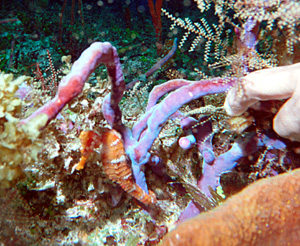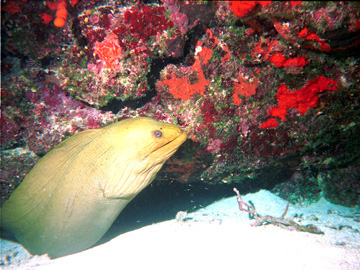Very early in our diving careers we visited the Mexican island of Cozumel, this is where I first started underwater photography and Wendy did her first dives in the ocean. After the trip I wrote this report for the scubadiving.com diver-to-diver message board, at the time this was owned and published by Rodale's. I ended up winning a wetsuit after this was voted equal first for best trip report for the month of November.
 |
|
|
Above is a Splendid Toadfish, a species of fish endemic to the reefs off Cozumel. |
|
Originally, this was going to be "Ten Dives in Belize", but the abrupt appearance of Hurricane Keith and the complexities of rescheduling in his wake put paid to that. Not willing to let adversity sway us, however, the early hours of November 12 found us humping bags into the truck and striking off through a thick, foggy pre-dawn for Houston, and then for Cozumel.
Well, that was the plan at least. The weather decided to have it’s way with us once more, grounding planes around Houston and delaying our departure by about five hours. On top of this, the plane we were meant to be taking to Cozumel decided to have a fit of pique and grounded itself in San Antonio. All due credit to the staff at Continental Airlines though, they seemed as frustrated as the rest of us and in due course distributed meal vouchers, drinks and snacks. A word from the wise here…the Wendy’s Bacon-Mushroom Melt, as interpreted at George Bush International Airport, is a horror. Do not go into the consumption of these things lightly.
Finally, after an extremely convincing rendition of eternity, a plane was diverted from Dallas to Houston for us, and a very full plane-load of slightly irritable scuba divers was on its way. A good thing too, the sight of a boarding gate full of divers gradually sending each other Pavlovian with their stories of previous trips to Cozumel was getting a bit disturbing. Wendy (no relation to the Bacon Mushroom Melt burger, and my most esteemed dive buddy) and I took no part in this story telling, as neither of us had visited Cozumel previously. For Wendy, other than an abortive attempt at an oil rig-dive in 6 foot seas out of Matagorda on the Gulf of Texas, diving experience to date had been solely fresh-water, predominantly three meter visibility, and often bone-numbing cold in a wetsuit that weighed almost as much as she does. I come from Australia originally, and have dived on and around the southern-most reefs of the Great Barrier Reef, but I had not dived in salt water for over a year, and never in a northern hemisphere ocean. This trip was well overdue for both of us.
A quick note here, I think in metric, use a metric computer and register temperatures on the Celsius scale. I will convert the depth and temp values to feet and Farenheit as we go along. I have included hyperlinks to businesses where possible, but this should not be taken as a direct endorsement or recommendation. I have numbered the dives sequentially from arrival in Cozumel, rather than day by day.
We travelled on a package deal via Continental Dive Vacations, with accommodation at the Hotel Costa Club, about a mile south of San Miguel’s downtown, and diving provided by Dive Paradise. We knew this would probably mean cattle-boat conditions and slightly less freedom to do our own thing than with some of the smaller operators, but beggars can’t be choosers, and we were happy to go with the flow. And I will state right here that, other than a tendency to run on Mexican time (which seems fair, it is Mexico after all), we had no problems or complaints with Dive Paradise, and nothing really bad to say about the operation. I would dive with them again if going for the same type of cheap package deal.
We checked in at the Costa Club, dumped our bags in the room, hauled out wetsuits/fins/regs/masks/boots and all the other paraphernalia, and headed to Dive Paradise to check in. After the necessities of waiver forms, certification card checks and scheduling were past, it was round to the Hotel Barracuda to get BC’s and tanks, and finally to the water's edge to begin:
DIVE ONE, 12 November 2000
Shore Dive at Barracuda Hotel, Max Depth 6.3 meters (20 feet), Water Temp 29 C (84 F), Bottom Time 16 minutes, no dive master.
Shallow and short, just enough time to get the kinks out of the wetsuits and check out our bouyancy control. There is a small rubble dump about 25 meters off the shore in front of Hotel Barracuda’s pier, which acts as an artificial reef. Visibility was about 15 meters (50 feet), mild current was apparent so we swam upstream for a while then practiced drifting back. While nothing like the extravaganza of fish life that was to come, we did sight goatfish, a small yellow stingray, blue tangs, a small smooth trunkfish, an anemone and a sea urchin. The sun was setting and we had no lights with us, so we finished the dive with heaps of air left. Wendy left the water with a gigantic grin, saying "I feel triumphant".
It had been a long and pretty frustrating day, and neither of us felt like eating out, so we dined in the Costa Club restaurant. Not exactly earthshattering, but not unpleasant either.
The next morning arrived clear and warm, setting a pattern that would be followed over the next week. We soon got into a routine, rolling out of bed and applying sunscreen, getting gear together (most of the heavy stuff we left in a locker at Marine Sports Cozumel, the Costa Club's dive facility), a stroll downtown for breakfast at the Rock'N Java Carribean Cafe, then back to the pier by 8:15 for the boat pickup. We found ourselves diving with essentially the same group of 12 to 15 divers each day, and none were the quintissential "newbie" type.
DIVE TWO, 13 November 2000
Chankanaab Ballones on the Esquarzos, Max Depth 21.8 meters (72 feet), Water Temp 28 C (82.5 F), Bottom Time 33 min, DM Oscar
Chankanaab Ballones is an area of coraline boulders surrounded by sand flats, sitting on a gently sloping bottom. The current here was quite prominent, so we mainly just drifted along behind the divemaster, giving each other our newly invented "Oh-my-god" hand signal. For those who are interested, this starts with two index fingers together in front of you, like the "get with your buddy" sign. Swoop the index fingers around so each makes half of a large circle, bringing hands back together at waist height. Put hands into "prayer" position and bow slightly at the waist. This was eventually abbreviated to the circling motion. Visibility was about 24 meters (80ft+)
The coral boulders were liberally supplied with fish, particularly prominent were Stoplight parrot fish, profuse grunts (French and Smallmouth), snappers and Schoolmasters in the mid-water, and Black Durgon. Smaller fish were also abundant, and I found some interesting invertebrates here and there. The defining moment of this dive was when Oscar found a GIGANTIC spiny lobster, who obviously knew he was protected and saw no need to hide in a hole on such a beautiful day. I didn’t have my camera with me, having planned to just relax and make sure my bouyancy was all OK before trying any photography.
Wendy had some eye irritation in this dive, which became much worse on the following dive. After a bit of experimentation we determined that it was probably her defog solution, so we threw that away and just went with spittle from then on. And it worked just fine.
DIVE THREE, 13 November 2000
Paradise Reef on the Esquarzos, Max Depth 13.4 meters (44 ft), Water Temp 28 C (82.5 F), Bottom Time 46 min, DM Oscar
Paradise is a patch reef system in fairly shallow water to the north of the cruise ship dock. I spent most of this dive looking under coral ledges and boulders, finding lobsters. Oscar scared out a small yellow stringray at one stage. The fish life here was much the same as seen at Chankanaab Ballones, I will add to the previous list Queen, Grey, and French Angel Fish, Rock Beauty, and an exquisite, tiny and jewel like Queen Angel fish juvenile (I presume) that was so bright I swear it had an internal light source. Visibility again about 24 meters (80ft). I thought to myself "gee, this would make a good night dive site", which turned out to be both prophetic and true.
DIVE FOUR, 13 November 2000
Las Palmas Wall on the Yucab II, Max Depth 17.9 meters (58 ft), Water Temp 28 C, Bottom Time 39 minutes, DM Mario
Our third dive of the day, mainly along the top of the wall as we had done a couple already and were still off-gassing. The current was going pretty well here, and we had our first experience of the "you are flying a jetplane" Cozumel drift dive experience. There were many more large sponges in this site than at the first few, and numerous small tiger groupers. This was my first dive with the camera (ever), so I had heaps of fun, swimming around like a mad thing and firing my strobe at everything that moved. The high point of this dive was when Mario found a Lined Seahorse. Taking photographs was a bit like trying to shoot seagulls out the side of a flying plane, but at least a couple turned out quite well (well, for a neophyte UW photographer, I thought they were OK). Wendy had decided to abandon her normal mask, and was using a SeaVision mask that we got as part of the original package to Belize. She raved about this mask, and continued to use it for the rest of the trip. We reckoned the visibility on this dive at 25-30 meters (80-90ft). At one stage, I allegedly pointed at something, so Wendy went over to have a look and found a Spotted Moray. "That is really cool" and "Oh-my-god" signs followed, then she swam off, leaving me none the wiser.
|
|
| A Lined Seahorse on Las Palmas Wall. Divemaster Mario's fingers off to the right |
DIVE FIVE, 14 November 2000
Palancar Horseshoe on the Aries, Max Depth 27.1 meters (90 feet), Bottom Time 32 minutes, DM Tony
The name Palancar seems to resonate through diving lore, and having been there, I can understand why. Spectacular cathedral like formations of coral perch over the edge of an abyssal drop, liberally festooned in rope sponges of all lengths and colors, purple vase sponges, large brown sponges, and a good variety of hard and soft corals. The roll-call of angel fish, butterfly fish, snappers, grunts and groupers just gets longer and longer. On this dive I saw a huge Scrawled Filefish and numerous triggerfish, mainly Sargassum. Stoplight and Rainbow parrot fish in profusion on the reef rim. We went through a couple of swimthroughs, though after a while I passed up on them so I could spend more time a bit shallower, looking for interesting things in the reef crevices. I did try looking around for pipe-horses at one stage, but with no luck. This is one area where being with a large group had a down side, I could quite happily have puttered around in the shallower areas for days, but felt a pressure to keep up with the group. Current was fairly mild and pleasant, this was a very enjoyable dive indeed. Visibility in the 30-35 meter range (90 to 100 ft).
DIVE SIX, 14 November 2000
Punta Tunich Wall on the Aries, Max Depth 23.7 meters (77 feet), Bottom Time 36 minutes, DM Tony
OK, enough of this gentle current stuff. We dropped in on Punta Tunich wall, and the current was HOWLING. We followed the reef rim rather than dropping down the wall, the current ran north->south, and it was just incredible. I had decided to try out my Seavision mask for this dive, which meant going without my prescription lenses, so I left the camera behind. Seeing the world through the Seavision mask was very strange. The rope sponges and purple vase sponges seemed to glow, while the orange color of my maximum depth needle shone like the setting sun. As we were flying along I spied a Spotted Moray totally out of his hole and lying on the reef surface, basically just watching the divers zipping by. I did a quick couple of kicks to catch up with Wendy, then turned and struck back towards the coral outcropping, just thirty or forty feet away. After about twenty seconds of doing a rendition of the Red Queen Effect (running as fast as you can in order to stay still), we gave it up and just floated away…
Just at the end of this dive, as we were starting to ascend for our safety stop, an Eagle Ray came tootling by just behind the reef rim. This was a moment to feel humility, there we were being tumbled about by the current, with little hope of making any progress against it, and yet the ray just effortlessly slid through the water, didn’t even look like it would be raising a sweat. Visibility on this dive we reckoned at about 25 meters (80 feet), though a bit less for me without the prescription lenses. Seeing the Eagle Ray though, even if a bit blurred, was the highlight of the dive, the day, and the trip so far.
DIVE SEVEN, 14 November 2000
Villablanca on the Aries, Max Depth 22.6 meters (74 feet), Bottom Time 42 minutes, DM Manuel
I had originally brought the camera along set up for macro, but when the divemaster described this site, I decided to leave the camera behind. The current was still screaming along, so this was yet another out of the "drift diving Cozumel style" mould. This dive was mid to late afternoon, and I got the impression that many of the fish were getting ready to go to bed. Particularly notable was the large number of Sargassum Triggerfish settling down into individual burrows, interspersed with small tiger groupers doing the same thing. At one stage I stuck my head into a cave and shined around a small light. At the back of the cave was a fairly large tiger grouper, so I motioned to Wendy to come over and have a look. As soon as she arrived she got a wild eyed look and started pointing down just beside my left knee, where I was kneeling in the sand. I followed her finger, and only then noticed that I was almost kneeling on top of a big, thick and powerful looking Green Moray tail. I really need to pay more attention to these morays! We eventually spotted his head in the same little cave as the grouper, about a foot away from where I had originally been. That was a bit of a close call...
DIVE EIGHT, 15 November 2000
Santa Rosa Wall on Meggie, Max Depth 24.9 meters (82 feet), Bottom Time 31 minutes, DM Tony
Drifting along another wall. Not as spectacular as the sites like Palancar or Punta Tunich, but fun none the less. This is another dive where the main purpose seems to be swimthroughs, which I am not all that fond of. They are fun the first few times, but after a while it was just "Ok, another cave". I tended to stay shallow with the camera again, and got some shots of large barracuda and parrotfish. My alignment of the strobe left a bit to be desired on this dive, oh well, just got to keep practicing. I reckon this would be a good sight for wide-angle photography, which I am not set up to do.
|
|
A healthy sized green moray, this fellow (?) has not missed too many meals. |
DIVE NINE, 16 November 2000
Chankanaab Reef on Meggie, Max Depth 14.5 meters (48 feet), Bottom Time 40 minutes, DM Tony
A very pretty, shallow, patch reef. I loved this place. Schools of grunts and snappers swirled over the reefs, Bermuda Chub came begging for food. I found and photographed a Green Moray, much to my delight. There was very mild current at depth, but the current picked up a bit during the safety stop, giving plenty of opportunity to watch the fish going about their business as we floated over them. I can say quite conclusively that this was my favorite of the shallow, patch reef formations we visited. I also think this would make an excellent night dive. The typical Carribean reef fish were present in abundance, basically if I have already mentioned it, it was there.
HALF TIME - INTERVAL
For Wednesday we had decided to take an afternoon break, and go for a night dive instead. This left us with time on our hands, so after cleaning up from the morning dives to Santa Rosa and Chankanaab, we decided to take a stroll into San Miguel proper, and have a look-see. Of course, this had to be THE day for cruise ship passengers, and the downtown plaza was absolutely seething with them. We quickly worked out how to identify the cruise-ship passengers at a distance. They travelled in packs, they wore blindingly white shoes and equally white t-shirts (which had been IRONED), and dripped with gold and diamonds. They had a characteristic walk, like they were floating an inch above the world, rather than being down there in it. As previously mentioned, neither of us had been to Cozumel before, so we have no idea what San Miguel was like before the advent of the big cruise ships, but I must say that it was not my favorite place, and I think it is sad. This caused a bit of a philosophical quandry for us, however. We were on a cheap package deal, and had only eaten out once in the time we had spent on the island. I was not certain how much we had actually contributed to the island's economy. Perhaps the cruise ship passengers actually bring more revenue to the island than we do... This was a sobering thought, and from then on I resolved to spend lots more money and eat out more. And on the upside, we only had to walk three blocks away from the plaza and the whiteshoe brigade rapidly dissipated.
END OF INTERVAL
DIVE TEN, 15 November 2000
Night Dive at Paradise Reef from the Aries, Max Depth 12.1 meters (40 feet), Bottom Time 50 minutes, DM not recorded (oops)
|
Well, what can I say besides "Oh-my-god". This was an incredible experience, the first time either of us have night dived on a reef. I took along the camera set up for macro, intending to have a "creature finding" dive. And the creatures were out in force. Probably I am most proud of the Orange Ball Corallimorph (with many thanks to ADS for the identification) which is pictured to the left. I found it under a small ledge at about 10 meters, and thought "wow, that's an interesting creature". So I spent a while maneuvering upside down to get the shot. I use an Ikelite Auto35 camera, which is fixed focus and fixed exposure. Given these limitations, I was ecstatic when I saw the print. Also on this dive were the requisite Flamingo Tongue Cowries and Brittle Stars on sponges, draping over coral and generally being Brittle Starish. I was particularly taken by the way the brittle star and hermit crab over to the right had very similar coloration. We descended almost straight on top of a very startled looking Octopus. Another highlight for the dive, and the best photo of the trip, was finding the Cozumel Toadfish whose picture starts this report. I have never, ever had quite as much fun on one dive as I did at this site.
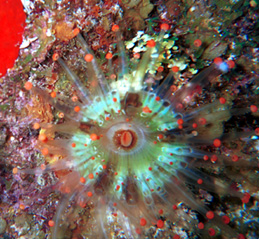 |
DIVE ELEVEN, 16 November 2000
San Fransisco Wall on the Nena, Max Depth 31.2 meters (102 feet), Bottom Time 34 minutes, DM Dakota
Until today, I was firmly of the belief that the Aries was the slowest boat in all of Cozumel. I revise my opinion. Nena was very pretty, with a recent paint job and quite a bit of deck space, but oh my did it take forever to get anywhere. I rapidly formed the opinion that the boat was being pushed by a pair of rather tired frogs, while somewhere up front a coxwain sat with a tom-tom drum to make engine noises. But hey, we got there in the end. San Fransisco is a pretty wall, without the swimthroughs that were so prominent at Palancar Horseshoe. Visibility was in the 30-40 meter (120-150 foot) range. We drifted along for most of the dive at about 19 meters, watching the fish flit about above us. The light seemed to cascade over the reef rim, backlighting the fish above us. The camera gave me trouble here, and I only took 10 frames, none of which are particularly good. I think there was so much light coming over the rim that it actually suppressed the external flash, leaving me with grey and murky results. Anyway, another fun dive and another site to cross off the list.
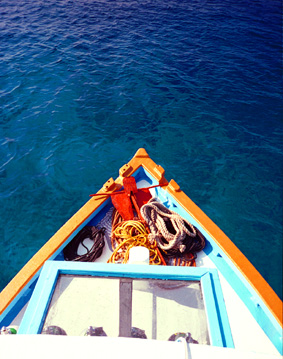 |
The Nena battles her way through adverse conditions... |
DIVE TWELVE, 16 November 2000
Yucab Reef on the Nena, Max Depth 15.9 meters (52 feet), Bottom Time 44 minutes, DM Dakota
Another very pretty patch reef in relatively shallow waters. There was a profusion of all sorts of life here. I found a scorpionfish, while Dakota the DM found a pair of Jackknife fish. Also a couple of Spotted Morays. Anemones and coraline "trees" were everywhere. At one point, as I was swimming with my hands behind me in a good streamlined position, a Bermuda Chub decided to have a taste of my fingers. More of a surprise than anything else, but Wendy found it terribly amusing. Sighted another Cozumel Toadfish on this dive, this one unearthed by Dakota.
DIVE THIRTEEN, 16 November 2000
Chankanaab Reef on Tango, Max Depth 14.2 meters (47 feet), Bottom Time 48 minutes, DM Manuel
Well if Dive Paradise uses frogs to drive their boats, someone had slipped some amyl-nitrate to Tango's. This boat howled along, actually planing for a change rather than doing the putter putter putter of the more typical slow-boats. We dropped in on Chankanaab at a slightly different spot to previously, and it took a bit of swimming before we made it to the reef proper. I had noticed that swimming against the current and trying to hold position while photographing were doing bad things to my air consumption, so I decided to leave the camera behind on this dive. Of course, all sorts of wild and crazy things put in an appearance. Spotted a baby spotted moray (about 25 cm long), a Queen Triggerfish in full filament streaming mode, Trumpet fish, another flamingo tongue cowrie, large crabs, brittle stars and arrow crabs everywhere. This was like a "swingshift" dive, I got the impression that all the daytime fish were getting ready for bed and the nightcreatures were just starting to stir. Still my favorite of the shallower patch reefs we visited in Cozumel.
DIVE FOURTEEN, 17 November 2000
Colombia Wall on Atlantis, Max Depth 31.9 meters (105 feet), Bottom Time 30 minutes, DM Tony
This site was in a similar vein to Palancar Horseshoe, with massive coral pinnacles standing in dramatic relief over the edge of the abyssal drop. Swim throughs were numerous and very popular, we often had to bunch up as a group and let other groups led by other DM's pass, all under the coral. I saw my first yellow tang on this dive. This was a very beautiful, very healthy reef with abundant small fish along the reef rim and easily 40 meter (150 foot) visibility. Current was very mild at depth, but picked up a bit along the reef rim.
|
DIVE FIFTEEN, 17 November 2000 This was our last dive with Dive Paradise. Another patch reef in moderately shallow water, similar in topography and fishlife to Yucab and Chankanaab, but probably the lesser of the three. Perhaps I was getting a bit jaded by this stage. I did manage to get a shot of a pair of Foureye Butterflyfish that I was quite happy with, and at the end of the dive during our safety-stop we drifted through a school of Ocean Triggerfish, which get my prize for the most unlikely style of swimming I have ever seen. Also spotted a large grouper, another Eagle Ray in the distance, a couple of Spotted Morays and a Peacock flounder. Visibility on this site was in the 25-35 meter range (80-100 feet). While not having the phenomenal diversity of Chankanaab or the wild and wooly current of Punta Tunich, it was a lovely site in it's own right and a fitting end to our diving with Dive Paradise. |
|
DIVE SIXTEEN, 17 November 2000 We brought our diving to an end for this trip with a shore dive on the plane wreck in front of the pier at La Ceiba hotel. For those who don't know, this plane was sunk deliberately during the filming of a James Bond movie (which one, I have no idea), and left in place after they had finished. The wreck is about 50 meters off shore directly in front of the hotel pier, and made a very interesting dive. The wreck is starting to break up, but the main superstructure is still readily visible. Swarms of grunts and juvenile Schoolmasters hover over the wings, while in the deeper hole visible in the photograph I found yet another Spotted Moray and a trumpet fish. While close in shore, and almost in the shadow of an enormous cruise ship, the life here and in the coraline boulders around the plane was quite diverse. I spotted a Midnight Parrotfish, a species I had not seen out on the open reefs, and a tiny little smooth file fish in a coral tree. We both really enjoyed the long bottom time in the shallow water, I found a cleaning station above a section of wing and we both sat on the bottom for a while watching the bright yellow cleaner fish at work on their customers. In the end, it was sunset that prompted us to leave. But I know we will be back. |
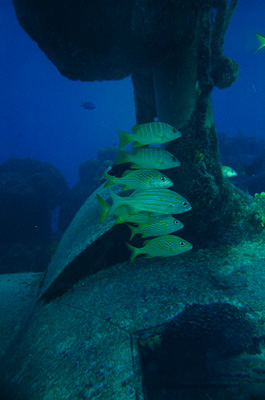 |
Well, if you have made it to this far you have my gratitude. I know that Cozumel is a very popular spot for divers on the board, and many of you will have been to the places I describe and have your own store of memories and images of this quite magical place. I will leave with a parting image, not of the diving but of a pair of divers we met early in our stay, and dove with throughout the week. KC and Betsy Brown were an older, retired couple from Austin, Texas, and they had the gregarious spirit and easy conversational style that I recognise in many of the Texans I have met. KC told us he had stopped logging his dives when he got his first two-stage regulator, ordered from a Sears and Roebuck catalogue. For forty years he had been patiently working at getting Betsy to dive with him, and two years ago he had succeeded. Now, they make four dive trips a year, and will not be stopping any time soon. "I think I've created a monster," he told us as we packed our gear from the last dive at Tormentos, with a smile as wide as the horizon. And I think Cozumel has made a monster of us.































































































































